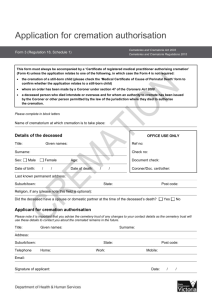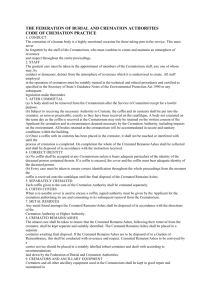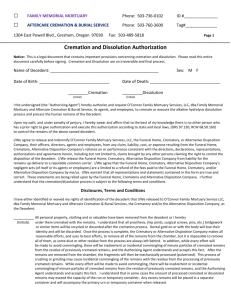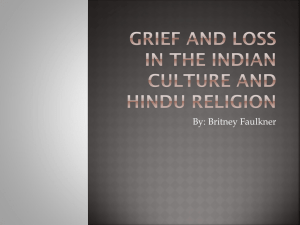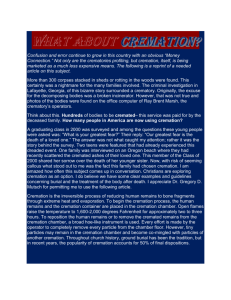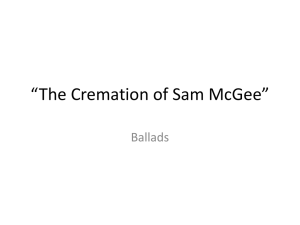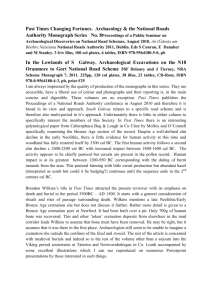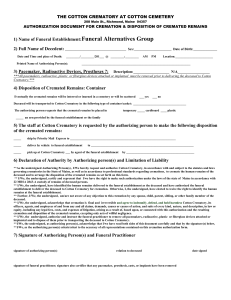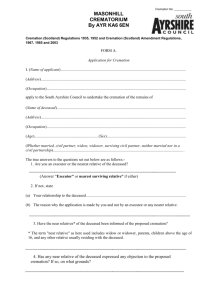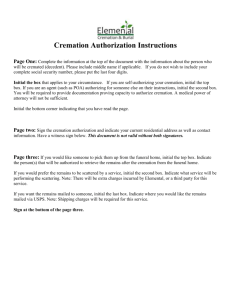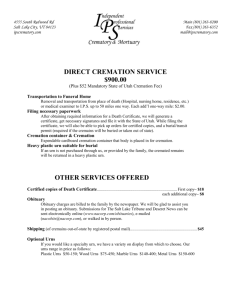Catholic Burial Practices (MS Word)
advertisement
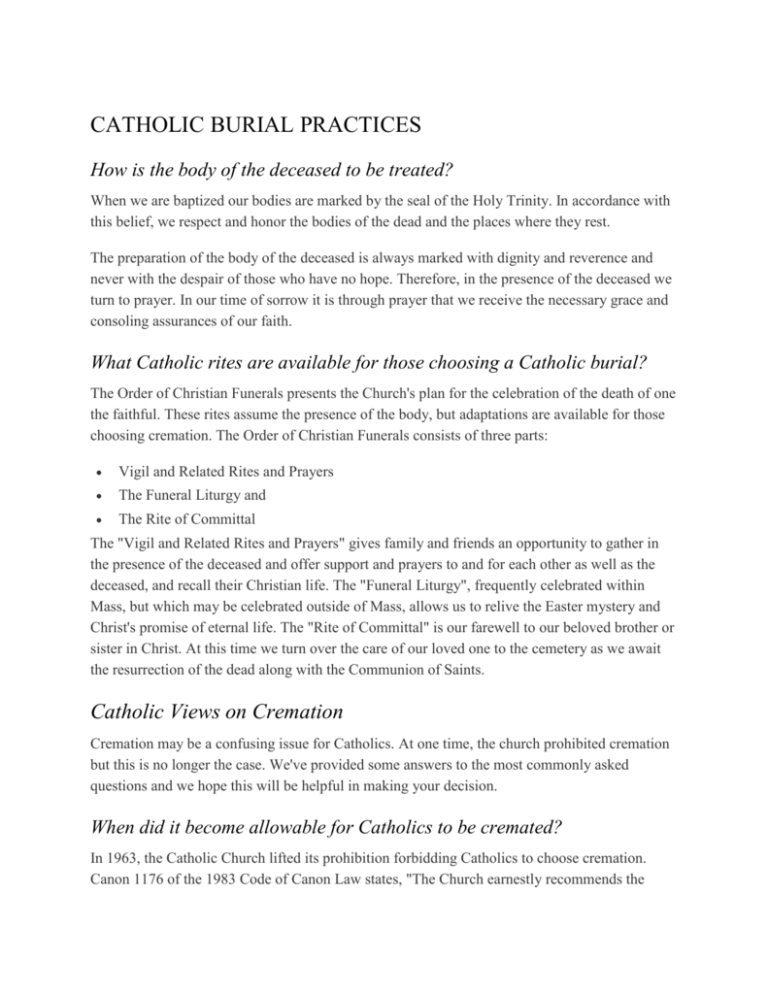
CATHOLIC BURIAL PRACTICES How is the body of the deceased to be treated? When we are baptized our bodies are marked by the seal of the Holy Trinity. In accordance with this belief, we respect and honor the bodies of the dead and the places where they rest. The preparation of the body of the deceased is always marked with dignity and reverence and never with the despair of those who have no hope. Therefore, in the presence of the deceased we turn to prayer. In our time of sorrow it is through prayer that we receive the necessary grace and consoling assurances of our faith. What Catholic rites are available for those choosing a Catholic burial? The Order of Christian Funerals presents the Church's plan for the celebration of the death of one the faithful. These rites assume the presence of the body, but adaptations are available for those choosing cremation. The Order of Christian Funerals consists of three parts: Vigil and Related Rites and Prayers The Funeral Liturgy and The Rite of Committal The "Vigil and Related Rites and Prayers" gives family and friends an opportunity to gather in the presence of the deceased and offer support and prayers to and for each other as well as the deceased, and recall their Christian life. The "Funeral Liturgy", frequently celebrated within Mass, but which may be celebrated outside of Mass, allows us to relive the Easter mystery and Christ's promise of eternal life. The "Rite of Committal" is our farewell to our beloved brother or sister in Christ. At this time we turn over the care of our loved one to the cemetery as we await the resurrection of the dead along with the Communion of Saints. Catholic Views on Cremation Cremation may be a confusing issue for Catholics. At one time, the church prohibited cremation but this is no longer the case. We've provided some answers to the most commonly asked questions and we hope this will be helpful in making your decision. When did it become allowable for Catholics to be cremated? In 1963, the Catholic Church lifted its prohibition forbidding Catholics to choose cremation. Canon 1176 of the 1983 Code of Canon Law states, "The Church earnestly recommends the pious custom of burying the bodies of the dead be observed, it does not however, forbid cremation unless it has been chosen for reasons which are contrary to Christian teaching." Why was cremation prohibited? Catholics believe that we are created in the image and likeness of God, and that all of God's creation is sacred. Just as the body should be treated with respect in life, so should it be treated in death. As Catholics we believe that "in baptism the body was marked with the seal of the Trinity and became the temple of the Holy Spirit," and as such, "Christians respect and honor the bodies of the dead and the places they rest" (OCF 19). During life our body was baptized into the Lord and His promise of eternal life. From the earliest days of Christianity, cremation was seen as a pagan ritual perceived to be contrary to this and other Catholic teachings, and therefore prohibited by the Catholic Church. Today, cremation is only prohibited if the person choosing cremation is doing so to deny Christian teachings, especially that of the resurrection of the dead and the immortality of the soul. What is cremation? Cremation is the process where the body is totally incinerated by intense heat and flame. All substances are consumed and vaporized except bone fragments and any noncombustible materials. The bone fragments may be further pulverized after cooling. These remains weigh anywhere from 4 to 10 pounds. What is the proper name for these remains? What we commonly call "ashes" are really not ash as we know it, but bone particles. The proper terminology of the remains of the body after cremation is cremated remains of the body. The Church also holds that these remains be treated with the same respect that the body was treated with prior to cremation, including the use of a "worthy vessel" or urn for the cremated remains of the body. When should cremation take place? The church strongly prefers that cremation takes place after the full Funeral Liturgy where the body is present. "This is the body once washed in baptism, anointed with the oil of salvation, and fed with the bread of life." The Church's belief in the sacredness of life and the resurrection of the dead encourages us to celebrate the funeral liturgies with the body present while affirming the value of human life. As Catholics we celebrate our funeral liturgies, because they recall Christ's victory over death. With His victory, comes our promise of eternal life. If it is not possible for the body to be present at the Funeral Mass, permission has been granted by the Catholic Church which provides for the celebration of the Funeral Mass with the cremated remains of the body present in church. Since it is the 'earthly remains' and not the body of the deceased that is present, there are slight adaptations in the liturgy. In some diocese, local permission is needed for the cremated remains of the body to be present at Mass. What Catholic rites are available for those choosing cremation? The same rights as those afforded to Catholics choosing full body burial. See above. How should cremated remains of the body be handled? Prior to cremation, arrangements should be made among the family of the deceased, the crematorium, the funeral director and the cemetery concerning the disposition of the cremated remains of the body. Most crematoriums will ship the cremated remains of the body via registered mail, or some other secure service, to the person who is responsible for them. Upon receipt, the cremated remains of the body should be treated with respect in the way they are handled, transported, cared for and in their final disposition. Upon receipt of the cremated remains of the body, what should I do with them? The cremated remains of the body should be buried or entombed. The scattering of the cremated remains of the body, or the keeping of them at home, or the dividing of them among various family members is not the reverent disposition the church requires. Most Catholic cemeteries have grave space or crypt space or niches for the cremated remains of the body. This allows for visitation, memorialization and prayers. At the cemetery, a final prayer "The Rite of Committal," is prayed as the cremated remains of the body are laid to rest. Recognizing that the goal of our lives is eternal life with God, we prepare for that by prayer, reception of the sacraments and care for those around us. Preparation for death is an essential part of life for a Christian. In today's society, for some, choosing cremation is part of that preparation for death. The Church continues to prefer and encourage the faithful to bury or entomb the bodies of their departed loved ones. However, if cremation is chosen for worthy motives, the church wishes to support the faithful in honoring the life and memory of the departed. References Christian Burial Guidelines, by the National Catholic Cemetery Conference, Copyright 2001. Cremation—New Options for Catholics, by Fran Helner, Catholic Update, St. Anthony Messenger Press, Copyright 1997. Honoring the Dead, Catholics and Cremation Today, by H. Richard Rutherford, C.S.C., The Liturgical Press, Copyright 2001. Order of Christian Funerals, prepared by International Commission on English in the Liturgy, Liturgical Training Publications, Copyright 1997. Order of Christian Funerals, Appendix Cremation, 1999 Federation of Diocesan Liturgical Commissions, the Worship Offices of Michigan and Ohio in consultation with Rev. Richard Rutherford. Reflections on the Body, Cremation and Catholic Funeral Rites, Committee on the Liturgy, National Conference of Catholic Bishops, Copyright 1997
